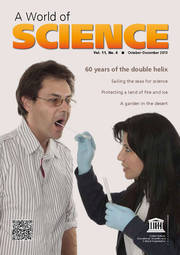Vol 1 N° 5 [October–December 2003]
CONTENTS
IN FOCUS
p 2 - The water crisis: how has it come to this?
NEWS
p 6 - 'We are more determined than ever’ to help Iraq
p 6 - Tailor-made science education programme for Timor-Leste
p 7 - Asian teens top performance rating in science and maths
p 8 - Stepping up exploration of inner space
p 9 - Satellites to the rescue of world heritage
p 10 - AIDS fight takes Africa’s First Ladies to Venice
p 10 - First-timers among new Biosphere Reserves
INTERVIEW
p 11 - Rita Colwell : Implications for UNESCO’s science programme of the US return
HORIZONS
p 13 - ‘Africanizing’ tropical forest management
p 17 - Poverty and reefs
IN BRIEF
p 19 - Governing bodies
p 20 - Diary p
20 - New releases
Quick link to Vol. 1 n° 5 (PDF document);
See also ARCHIVES for A World of Science
EDITORIAL
Talk is cheap
Far from the headlines, Israeli and Palestinian scientists have spent the past four years discussing how to improve the lot of Palestinian children. With the only teaching aid in most schools a blackboard, Palestinian teachers are ill-equipped to help their pupils demystify science. This state of affairs would sadden any scientist. It has spurred this group to act.
Realizing it would be financially unfeasible to equip every Palestinian school with a laboratory, the Al Quds University in East Jerusalem and Bloomfield Science Museum in West Jerusalem imagined an Interactive Science Centre hosted by the former institution and supported by the latter. The centre would enrich the Palestinian science programme by giving children the opportunity to observe natural phenomena and conduct experiments of their own and, at the same time, encourage a vocation for science. The centre could showcase Palestinian research and industry and, by opening its doors to the general public, would foster science popularization.
The project quickly captured the imagination of other partners, including the Andrea and Charles Bronfman Philanthropies (ACBP) in Israel, the Hebrew University of Jerusalem and the University Federico II in Naples (Italy). All took part in a meeting organized by UNESCO, the European Collaborative for Science, Industry and Technology Exhibitions and the Città della Scienza in Naples last June to carry the project forward. Now the partners are about to take a travelling science exhibition on the road to build public awareness and raise funds to complement those already donated to the centre by the ACBP, European Union and Napolitan Region.
Talk is cheap. We can talk about the virtues of peace until we are hoarse; it doesn’t cost anything and it makes us feel good. But that is not peace-building. Peace-building means translating words into deeds.
SESAME is a word. But it is above all a deed. Or rather, a succession of deeds: there are the scientists from within and beyond the Middle East who have spent the past six years drumming up support for a research centre of international standing for the Middle East by the name of SESAME; there is UNESCO, which has acted as mentor; and Germany, donor of the ‘centrepiece’, a synchrotron light source; there is Jordan, which has agreed to host the SESAME centre, currently under construction; and there are Bahrain, Egypt, Iran, Israel, Jordan, Pakistan, the Palestinian Authority, Turkey and the United Arab Emirates who have all agreed to share the centre. Deeds, not words.
World Science Day for Peace and Development comes around again on 10 November. It will be an occasion for all of us to ask what we, as scientists, can do to make a difference.
W. Erdelen
Assistant Director-General for Natural Sciences

